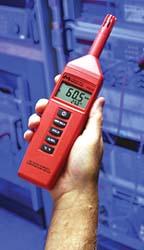
A variety of factors affect people's environmental indoor comfort levels, including temperature, relative humidity (RH), air movement, clothing, activity level, and individual physiology. By regularly testing temperature, RH, and CO2 at various locations in the ventilation system, you can determine where and when air quality problems exist, identify the source, and maintain optimal comfort levels for building occupants.
Common Causes Of Poor IAQ
Inadequate ventilation, inefficient filtration, and poor air-handling unit hygiene are the most documented reasons for IAQ problems. Less frequently, specific pollutant sources can affect the IAQ of either the building or a localized area within the building.From an occupant's perspective, these issues often translate into uncomfortable temperatures and humidity levels. Abnormal temperatures can affect both general comfort and people's ability to concentrate. Heating air lowers the humidity. RH below 30 percent can contribute to eye and respiratory symptoms. High humidity or water leaks can lead to mold.

Temperature And RH
Temperature and RH can be determined using a thermometer and sling psychrometer or a digital thermometer and electronic RH meter (digital hygrometer). Whichever you choose, make sure your tools are accurate within ±1 degree F for temperature measurements.During each measurement, allow time for the reading to stabilize to normal conditions. This may take several minutes on older analog instruments, while newer digital thermometers, such as the Fluke Model 50 Series, are quick to respond and offer an illuminated display, minimum and maximum readouts, and multiple reading time stamps for taking measurements at several test points.
Electronic RH meters, such as the Meterman TRH22, are simpler to use than sling psychrometers and provide both RH and temperature readings. Since indoor RH is influenced by outdoor conditions, a single indoor measurement may not reflect long-term RH in the building. The best practice is to take multiple readings to get a more accurate analysis of building conditions.

Next, verify the accuracy of the control system by measuring next to the thermostats controlling the zone. Then, measure at the location of the complaints and evaluate whether they're within the comfort zone. Large variations between readings may indicate a room air distribution or mixing problem. High variations over time may indicate control or balance problems with the HVAC systems.
Next, use the temperature readings to determine the actual amount of fresh air entering the building. The American Society of Heating, Refrigerating, and Air-Conditioning Engineers (ASHRAE) codes require minimum amounts of cfm (cubic feet per minute) per person, depending on the type of occupied space (typically 15 cfm/person). See Table 2 for the ASHRAE Standard 62-2001, "Ventilation for Acceptable Indoor Air Quality" minimum cfm requirements.

CO2 And Ventilation
CO2 is a normal part of the atmosphere, and exhaled breath from building occupants is an important indoor CO2 source. Indoor CO2 concentrations can, under some test conditions, provide a good indication of the adequacy of ventilation.Comparing peak CO2 readings between rooms, between air-handler zones, and at varying heights above the floor may help you identify and diagnose various building ventilation deficiencies.
Use either a direct-reading meter or a detector tube kit to measure CO2, noting the relative occupancy, air damper settings, and weather for each testing period.
For ventilation, collect CO2 measurements away from sources that could influence the reading (e.g., hold the sampling device away from exhaled breath).
Individual measurements should be short term. Start by taking one or more readings in control locations, near the outdoor air intake or in areas with no apparent IAQ problems, to serve as baselines for comparison.
Then, compare measurements at different times of day. If the occupant population is fairly stable during business hours, CO2 levels will typically rise during the morning, fall during lunch, and then rise again, reaching a peak in mid-afternoon. In this case, mid- to late afternoon will be the best time to evaluate your ventilation's adequacy.

Using The Results
Concentrations below 1,000 parts per million (ppm) generally indicate adequate ventilation, but not always.If strong contaminant sources are present, you may need to control that source to protect air quality.
Measurement errors and varying CO2 concentrations over time can also cause misleading readings.
Peak CO2 concentrations above 1,000 ppm in the breathing zone indicate ventilation problems. Elevated CO2 may be due to one or more causes, such as: increased occupant population, air exchange rates below ASHRAE guidelines, poor air distribution, and poor air mixing.
A higher average CO2 concentration in the general breathing zone (at least 2 feet from exhaled breath) than in the air entering return grilles indicates poor air mixing. In that case, use smoke tubes and temperature profiles to clarify air circulation patterns.
If CO2 measurements taken before the occupied period begins are higher than outdoor readings taken at the same time, the HVAC system may have an operating problem.
Potential problems include:
Outdoor CO2 concentrations above 400 ppm may indicate an outdoor contamination problem from traffic or other combustion sources.
Inadequate ventilation can also be due to nonenforcement of building codes and poor contractor and maintenance practices. These inadequacies are detrimental to delivering good indoor air quality, especially in public buildings such as offices and schools.
For more information, contact the Occupational Safety and Health Administration (OSHA) or ASHRAE for recommended building level temperatures, RH levels, cfm, and CO2 levels for the building. Today's ventilation systems offer more precise controls than ever, but nature still can throw us curveballs. Thankfully, temperature, RH, and CO2 tests make it easy to track system performance and prepare for adverse weather. With regular testing and preventive maintenance, you can limit the chances of uncomfortable environmental conditions occurring in the building.
Jourdan is program director of Environmental Systems & Refrigeration Technology at Wenatchee Valley College (Wenatchee, Wash.). He prepared this article with Fluke Corp. For more information, contact the author at gjourdan@wvc.edu or visit www.fluke.com.
Publication date: 05/10/2004

Report Abusive Comment